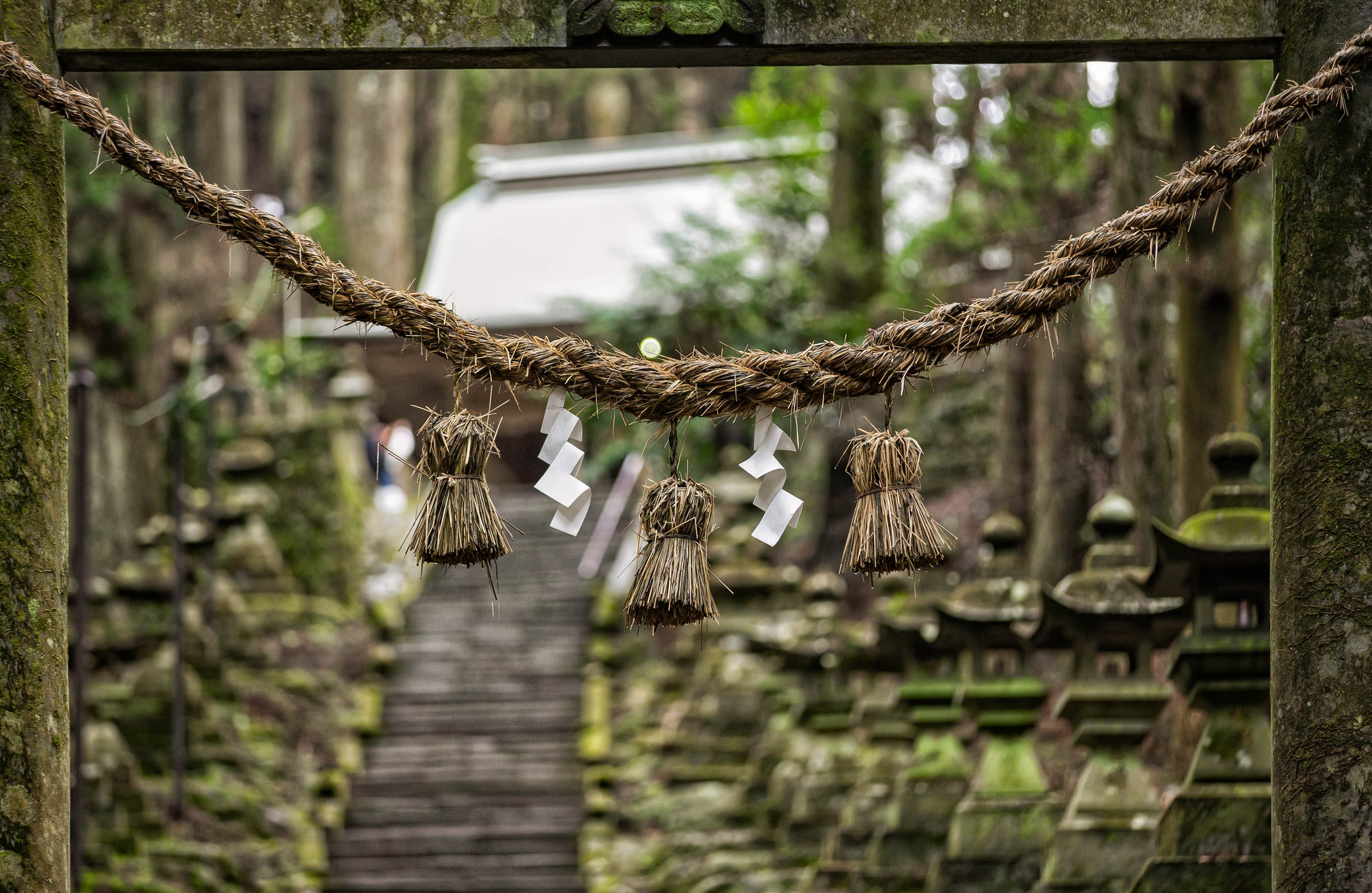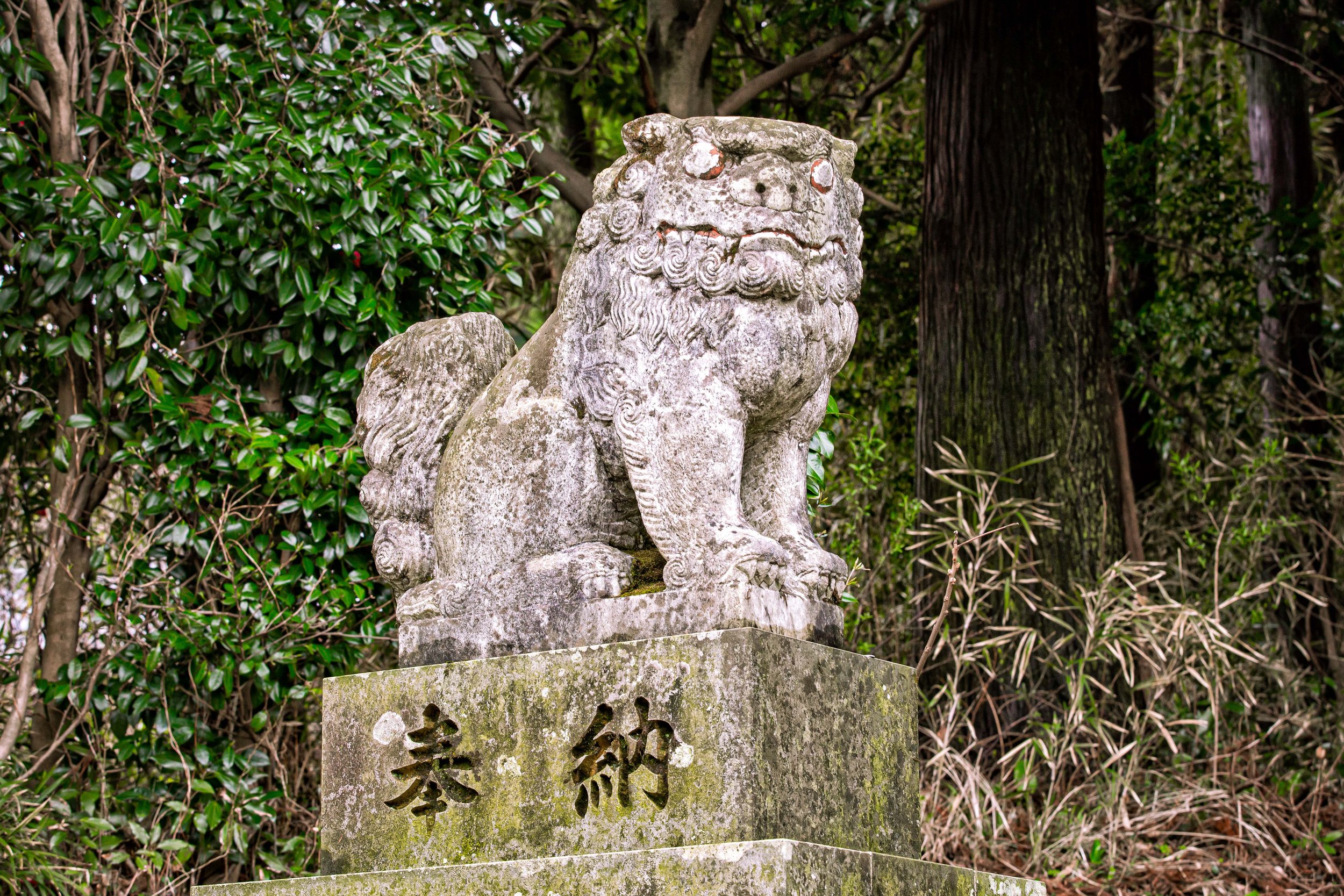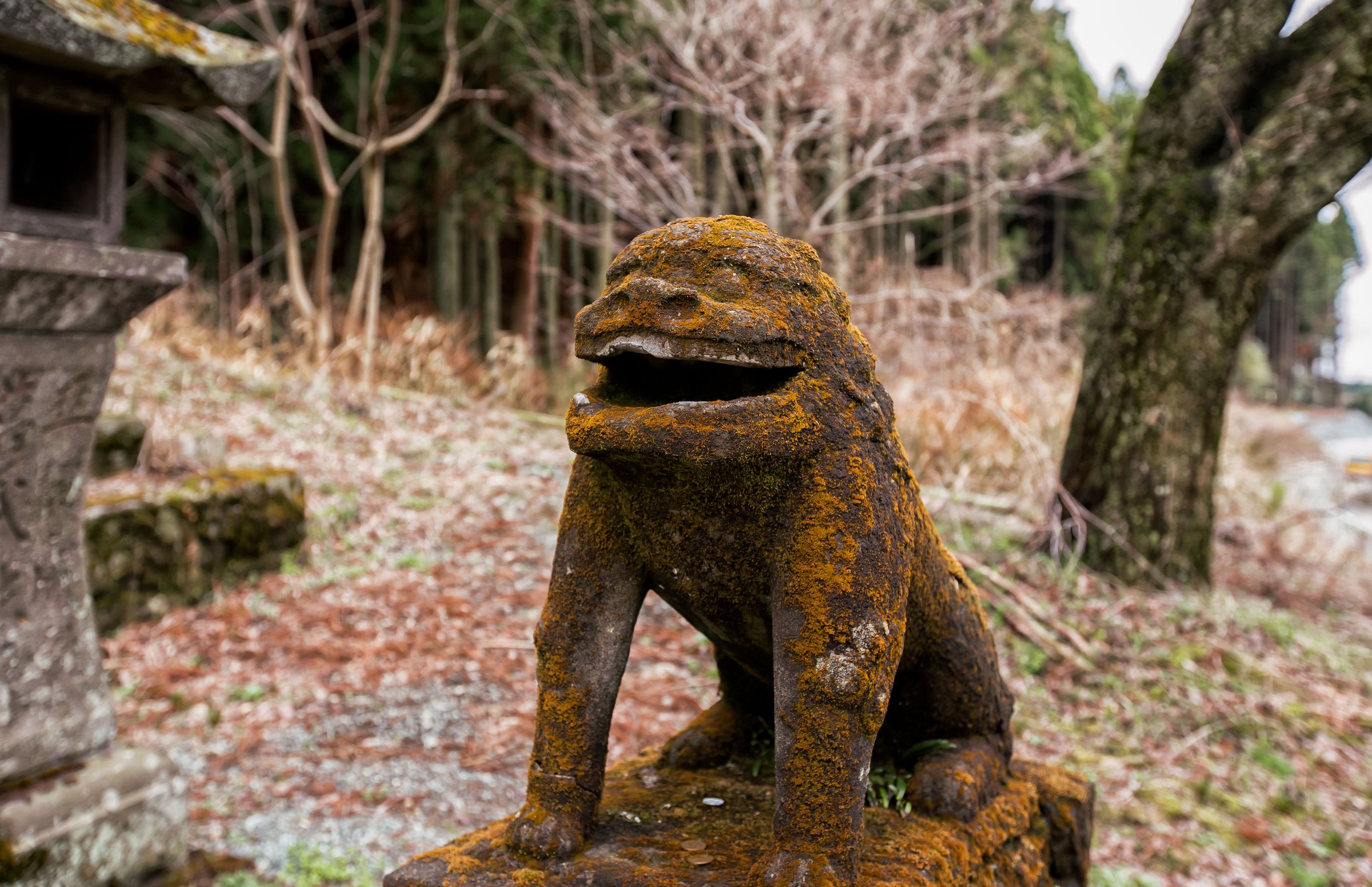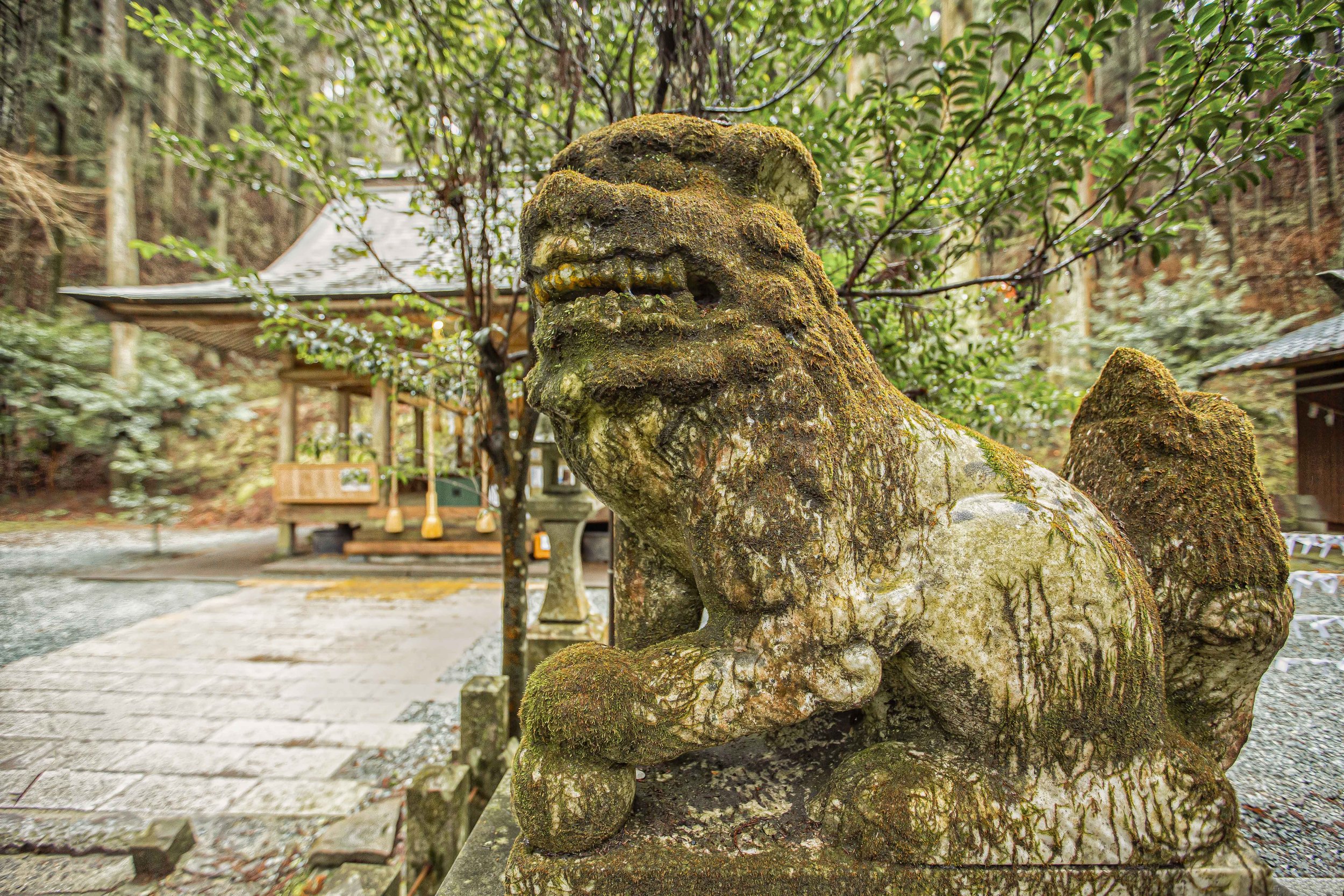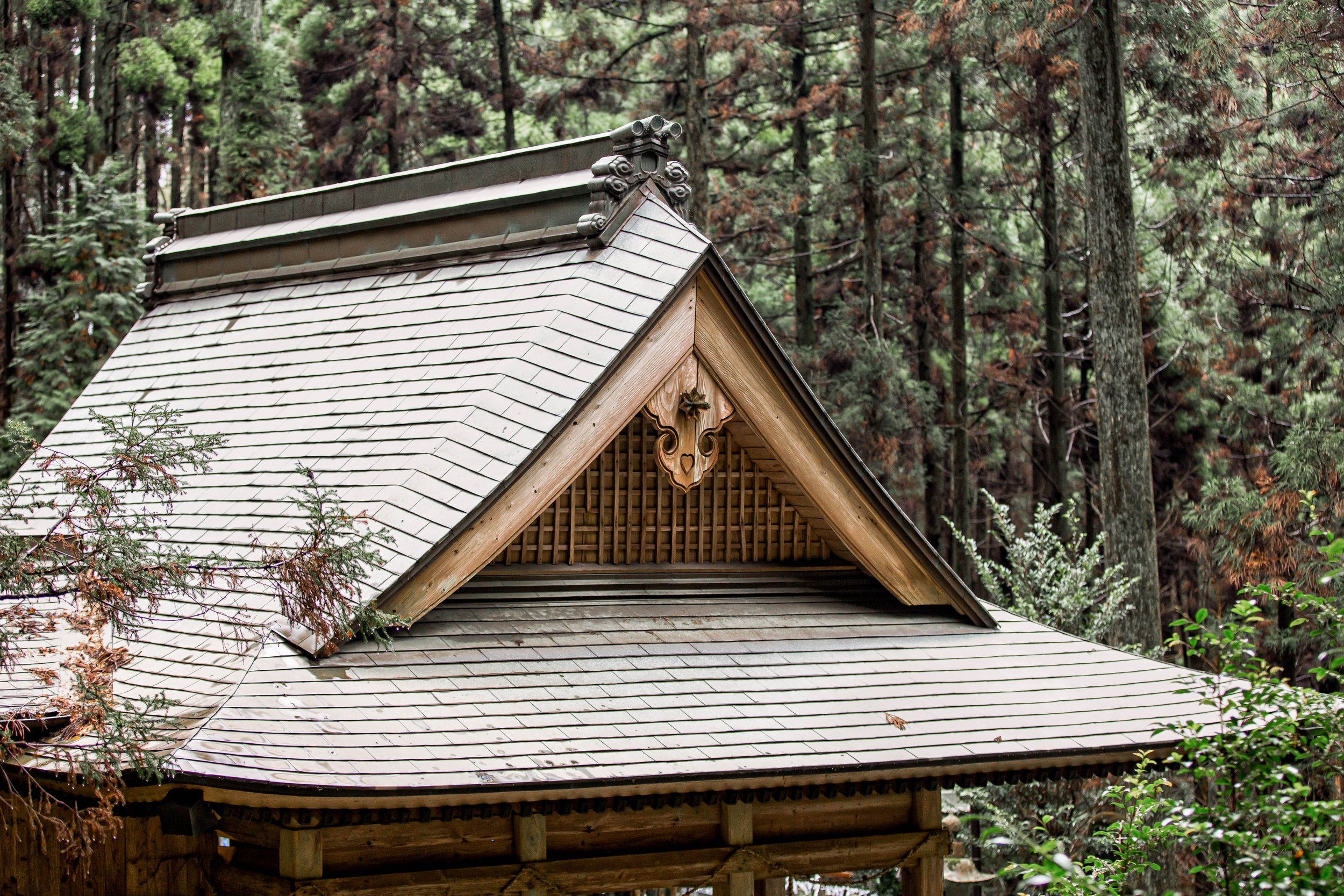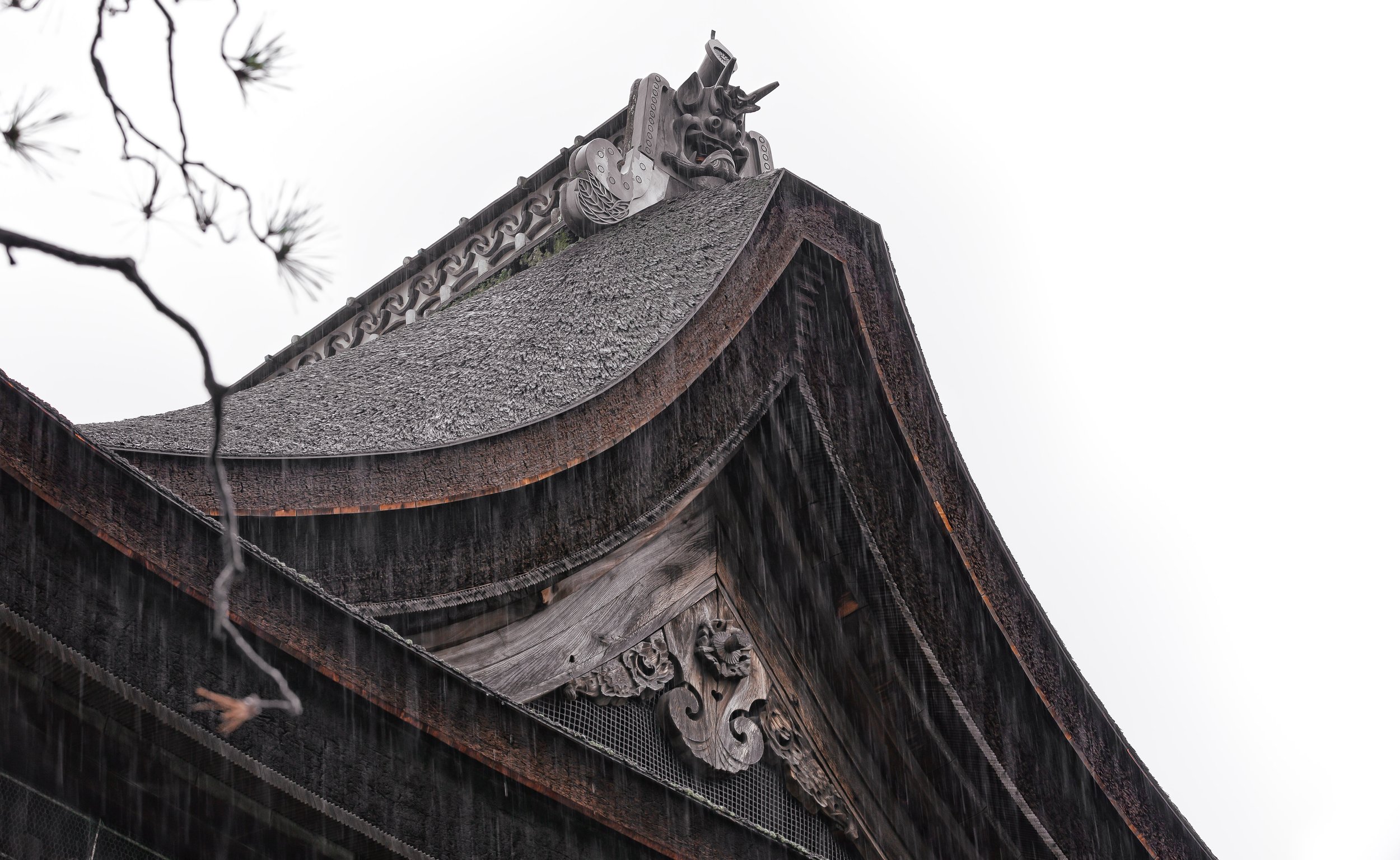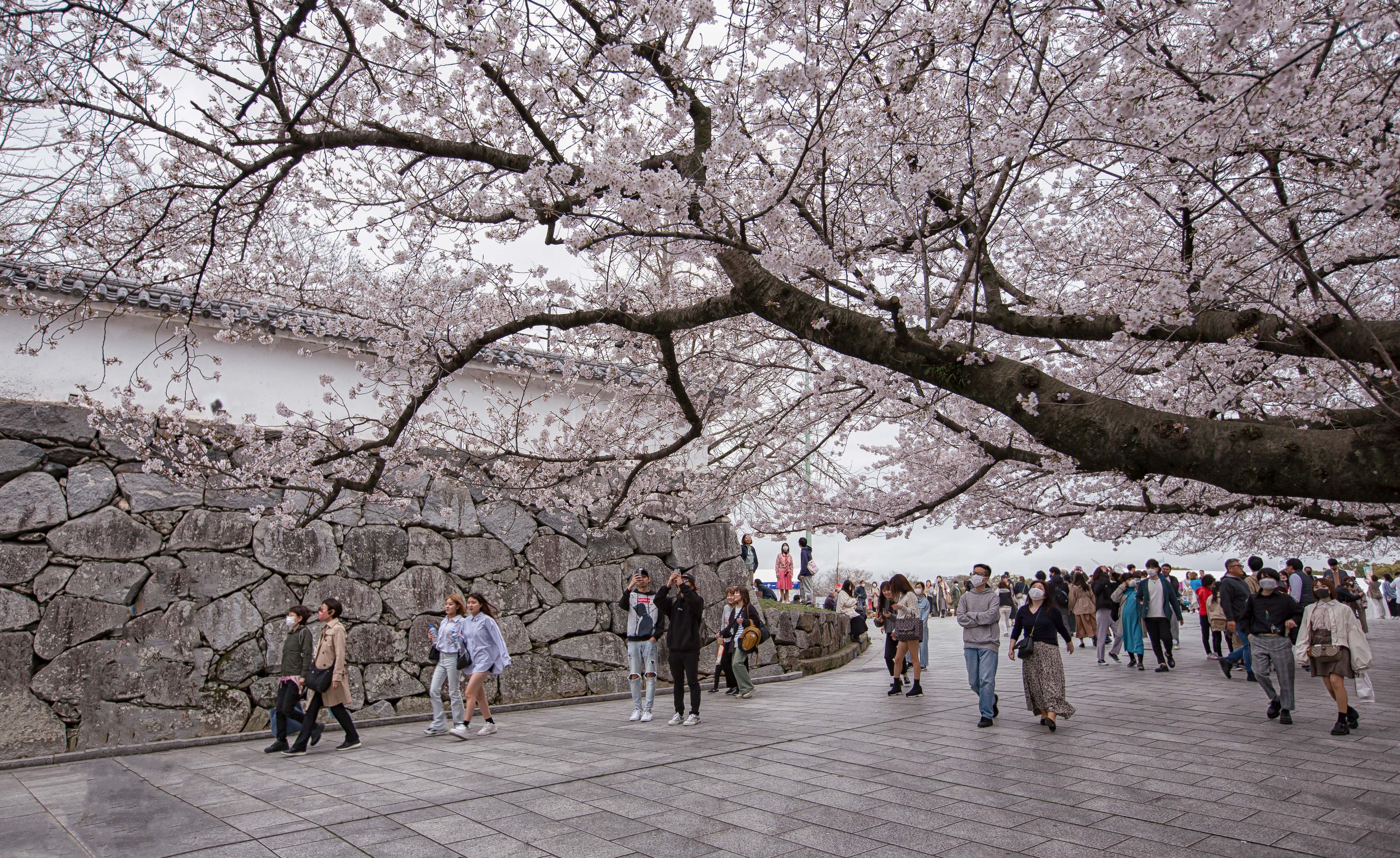I tend to be rather easy-going, so while we were planning our trip to Kyushu, one of our ideas was to stop in Kumamoto City (熊本市) for a night so that we could check out the city’s famous castle, and some of its other sights. After doing a bit of research, however, we found out that the castle was undergoing a massive restoration project as a result of the damage caused by the 2016 Kumamoto Earthquakes. With that souring our plans a bit, my partner suggested we spend a little more time in the Mount Aso (阿蘇山) region, which would include a trip to the top of the volcano, a beautiful gorge, and a couple historic Shinto Shrines.
I thought hey, why not, I mean, I’ve been to Europe and seen my fair share of castles, and I’m not all that impressed by them anymore. Being a bit of a nerd, I had known about Mount Aso for quite a while as it is the home of Godzilla’s frienemy, Rodan (ラドン), the winged fire-demon!
Once in the countryside in the midst of the famed volcano, my partner decided enough was enough and that it was my turn to drive the car. I’ve never actually driven on the ‘right’ side before, so we stopped off in an empty parking lot, and I circled around a few times before I felt confident enough to get on the road. Fortunately, drivers in Japan drive really slowly and really politely, so I was able to get the hang of it in no time.
Unfortunately, as we approached the caldera of the volcano, which is apparently quite beautiful, an incredibly thick fog surrounded us, and although we kept making our way to the parking lot in the hope that it would clear up, once we arrived and made our way to the viewing area, visibility was pretty non-existent.
Feeling somewhat defeated, my partner said to me - “Don’t worry! We have a backup destination. Something I think you’ll enjoy.”
We got back in the car and she input the address of our next destination into the GPS and we were on our way - About an hour later we pulled into an empty parking lot with a food truck that was selling gourmet hotdogs. I scratched my head and wondered if she knew something about these hot dogs that I didn’t, but she laughed and we started walking down the road. About two minutes later we arrived at a set of stairs that featured a shrine gate, and a set of stone lion-dog guardians, so I felt a bit of relief.
I’m not a big fan of hot dogs.
Walking up the stairs to the shrine, it took us about two minutes before we realized that this ‘backup’ destination was likely to become the highlight of our entire trip to Japan. I would later discover that the shrine was the inspiration for a recent Japanese movie, but that was something we were both completely unaware of before arriving.
The thing about Shinto Shrines in Japan is that they’re pretty much everywhere you go, but when you’re able to find one deep in the forest on a mountain like this, they’re a lot more special as they blend so effortlessly in the nature that surrounds them, and this was exactly the experience that I was looking forward to the most.
Link: Into the Forest of Fireflies' Light 蛍火の杜へ (Wiki)
If you’ve seen the film, "Into the Forest of Fireflies' Light” (蛍火の杜へ / ほたるびのもりへ), you may have an idea of what I’m talking about when I try to describe how beautiful this shine is, but if you haven’t, let me take a minute to try to set the scene: At an elevation of about 670 meters on the slopes of Mount Aso, you’ll find a narrow stone path with around three hundred stone steps that climbs a hill in a thick forest of Japanese cedar.
The stone path features nearly one-hundred stone lanterns on either side, each of which has progressively been reclaimed by nature, with thick green moss growing on them. Walking up the stairs, the path is dark, with a mixture of fog and sunlight battling to make their way through the thick forest.
The shrine is eerily quiet, with only the sound of woodpeckers and other animals going about their business. At times you might hear bells ringing, or the chattering of visitors, but if you’re lucky enough to visit when no one else is there, it’s an almost zen-like experience where you’ll feel incredibly relaxed as you make your way up the hill to the shrine.
I wish I could say that the photos I took of the shrine did it justice, but having visited the shrine, the experience of enjoying its peace and quiet is something that probably doesn’t translate as well as I’d like.
The ‘Kamishikimi Kumanoimasu Shrine’ has become a popular destination for travelers in recent years, likely thanks to being featured in the anime, but it is a place of worship that has been around for a very long time. Although although most of what you see at the shrine today is a product of the last century, the shrine has a history of human activity that dates back to the 4th and 5th centuries with the shrine itself possibly dating back to the Kamakura (1185–1333) or Muromachi Periods (1336 to 1573).
Unfortunately there is very little information as to when the shrine was actually established, it’s safe to say that whether its more than a thousand years old or not, it’s probably never been as popular as it is today with visitors from all over the world coming to experience it’s beauty.
As I move on below, I’m going to introduce the origin of the shrine and the kami worshiped there. I’ll then move on to explaining each of the important aspects of the shrine that visitors should pay attention to.
Sadly, there isn’t much written about the shrine apart from simple introductions, so I hope this article helps more people understand what they’ll see when the visit.
Kamishikimi Kumanoimasu Shrine (上色見熊野座神社)
To start introducing the shrine, I think it’s probably a good idea to first break down it’s official name, which actually tells us a lot about its history, and its affiliations.
English: Kamishikimi Kumanoimasu Shrine
Kanji: 上色見熊野座神社
Hiragana: かみしきみくまのざじんじゃ
So let’s start out by breaking down the first part, ‘Kamishikimi’ (上色見)
In the Japanese language, certain Kanji can have a number of pronunciations, so it’s important to note that the ‘Kami’ in the name here isn’t actually referring to Shinto deities - Instead, ‘kami’ (上 / かみ) refers to the ‘upper' reaches of a mountain or a stream. Or, at least, the upper area of ‘Shikimi Village’ (上色村 / しきみむら). In fact, this shrine isn’t the only ‘Shikimi-Kumanoimasu’ Shrine in town, so the ‘kami’ in this case helps to differentiate the two. The second part of the first word, ‘Shikimi’ was once a village within Kumomoto’s Aso County (阿蘇郡) until 1955, when the village was amalgamated into Takamori District (高森町). Situated on the South-Eastern slopes of Mount Aso, the village has traditionally been an agricultural area, with only a small number of residents.
The second part of the name is quite important as it points to the shrine’s affiliation, as it is part of a network of 3,000 shrines that have a relationship with the Kumano Sanzan (熊野三山) shrines in Wakayama Prefecture (和歌山県) on the Main Island’s Southern Kansai Region (関西地方).
The ‘Kumano Sanzan’ are three shrines, which act as the spiritual headquarters for a sect of that is known for its syncretism of Shintoism and Buddhism, known as ‘shinbutsu-shūgō’ (神仏習合 / しんぶつしゅうごう). The Kumano region has been known since ancient times as a place of physical healing, and has become the site of one of the world’s largest religious pilgrimages as people from all walks of life from all over Japan come together to traverse the mountains on a pilgrimage to visit the three shrines.
For a shrine to become affiliated with the Kumano sect, it needs to take part in a ‘divinity-sharing’ pilgrimage in which the power of the Kumano deities are divided up and shared with new members.
Now that we know what the name of the shrine is referring to, let’s talk a bit about it’s history, which unfortunately isn’t very well documented.
It’s unclear as to when the shrine was officially established, but it’s important to keep in mind that even though much of what you’ll see there today is relatively new, people have been coming to this location for a long, long time. As I mentioned earlier, quite a few burial mounds dating back to the 4th and 5th century have been discovered on-site, so it’s safe to say that human activity in the area has been taking place for more than 1500 years.
One of the main reasons why the area became an important religious space was thanks to the rare Ugeto-iwa Cave (穿戸岩) that sits high above where the shrine is located today - Given that one of the core aspects of Shintoism is that ‘kami’ are believed to inhabit all things, including forces of nature and prominent landscape locations, it’s understandable that the rock would become a place of interest, especially for people living in the area more than a thousand years ago. As an important aspect of the shrine’s precinct, the cave also lends to regional legends, which have helped to determine the ‘kami’ who are worshiped at the shrine.
That being said, as I mentioned earlier, it is thought that the shrine may have been established sometime between 1185–1573. Officially, what we do know is that at some point during the 16th century, much of the original shrine was burnt to the ground during the Sengoku Period (戦国時代), otherwise known as Japan’s Warring States Period.
Estimated to have been burnt down sometime between 1573 and 1593, the shrine would have been reconstructed shortly thereafter, nevertheless, it was rebuilt again in 1722, and then again in 1979.
Obviously, as a Kumano Shrine, one of the key things to remember is that the shrine shares a special relationship with the natural environment that surrounds it. With that in mind, it’s important to point out that there are legends told in both the Kojiki (故事書) and Nihon Shoki (日本書紀), which play an important role with regard to the origin of the shrine, and to that extent, the formation of human settlements in the Mount Aso region.
To explain that though, let me first introduce the three ‘kami’ who call the shrine home:
There are three kami enshrined at the shrine, the first two of which are important figures within the Shinto creation myth. The third deity is a much more regional figure, but also hails from the same ‘lineage’ as the other two deities, and the creation of Japan as a landmass and a nation.
The first two kami pretty much go hand-in-hand with each other as they are the central figures in the Japanese creation myth - Brother Izanagi (伊邪那岐命 / いさなき の みこと) and sister Izanami (伊邪那美命 / いざなみのみこと), whose names can be translated as “He Who Invites” and “She Who Invites,” respectively. As important figures in Japan’s creation myth, they are responsible for not only the formation of the islands that make up the Japanese nation, but also a number of other important Shinto deities.
Tales of their exploits are told as myths in the Kojiki and Nihon Shoki, and as the Japanese Imperial Family claims ancestry from their daughter, Amaterasu (天照大神), who it is said sent her own son to earth to rule over Japan as its first emperor.
The important thing to keep in mind about the Izanami and Izanagi enshrined here is that they are connected to a network of over 3,000 shrines in Japan where their divinity has been shared by a process of propagation called bunrei (分霊) or kanjō (勧請). Basically, it’s a process of ‘dividing’ the power of a deity. Shared directly from the Kumano Sanzan (熊野三山) shrines mentioned earlier.
Now, let’s get into some specifics about the third kami, which is a figure that is closely related to the Mount Aso region in addition to being someone who could is considered a distant relative of Izanagi and Izanami.
General Ishikun (石君大将軍 / たけいわたつのみこと)
One of the more confusing aspects with regard to my research about the shrine was when it came to identifying who ‘General Ishikun’ actually was. With the title ‘Seii Taishōgun’ (征夷大将軍 / せいいたいしょうぐん), or what we would refer to as a ‘Shogun’ in the west, one might come to the conclusion that the ‘Ishikun’ enshrined here might have been a historic army commander, who shared a relationship with the Shikimi region.
After an hour or so of searching for information about the shogun, I discovered that he wasn’t actually a ‘shogun' at all, it is just another name for ‘Takeiwatatsu no Mikoto’ (健磐龍命 / たけいわたつのみこと), a legendary figure known in the region as the god of agriculture.
Considered to be the grandson of Emperor Jimmu (神武天皇 / じんむてんのう), the first emperor of Japan, myths of his life are told in the Kojiki and Nihon Shoki, but given how incredible the stories are, it’s debated whether or not he ever existed. Suffice to say, legends explain that Takeiwatatsu was sent to the region of Kyushu we know as ‘Aso’ (阿蘇) today to assist in the creation of an agricultural community there.
With divine abilities thanks to his great grandmother, the Goddess Amaterasu, it is said that he traversed Aso Mountain (阿蘇山) and forcibly kicked down part of the caldera’s rim, which drained its volcanic lake, allowing the local people to become incredibly successful farmers.
Takeiwatatsu no Mikoto is today the primary deity enshrined within the Aso Shrine (阿蘇神社), the highest-ranking shrine in Kumamoto Prefecture (熊本縣), and many of the other Shinto Shrines in the region worship him as well, including this shrine.
How Takeiwatatsu no Mikoto relates to this shrine in particular, however, is an interesting part of the region’s folklore, thanks to the legends told in the Kojiki. Essentially the story goes a little like this - While Takeiwatatsu was doing his ‘work’ on Mount Aso, helping to shape the land, allowing for the volcanic water to help with irrigation, he often took breaks to practice shooting his bow as he was also a gifted archer.
With his assistant Kihachi (鬼八) by his side, he shot ninety-nine arrows from the peak of Mount Aso, with his assistant running off into the distance to retrieve them. By the time he shot the one-hundredth arrow however, Kihachi was exhausted. So, instead of carrying the arrow back, he kicked it toward Takeiwatatsu, who got angry and pursued him around the mountain. Kihachi fled for his life, but he found himself blocked by a rock and couldn’t escape, so he used his last bit of strength to kick it in.
Unfortunately, he was eventually caught and Takeiwatatsu cut his head off.
The giant hole in the mountain thus is part of legends that date back as far as the Kojiki, which was written between 711-712.
Interestingly, there is a shrine nearby that is dedicated to Kihachi, who was thought to have turned into an ‘evil spirit’ after being murdered by Takeiwatatsu. Seeking revenge for his murder, he destroyed all of the crops that were planted in the area. So, to appease Kihachi’s tormented soul, Takeiwatatsu had his head enshrined at the Shimomiya Shrine.
Read more about the shrine, and its unique annual event in the link below:
Link: Shimomiya Shrine - A small shrine that holds an interesting yearly event (Japan Travel)
As to the reason why the name ‘General Ishikun’ was used instead of the title that more people are familiar with, I still haven’t figured that out - If anyone has any idea, feel free to let me know in the comments below!
Architectural Design
As mentioned earlier, there isn’t particularly a lot for tourists to see and do in the Takamori area, but in recent years thanks to it’s likeness appearing in a popular Japanese anime, the shrine attracts a fair number of tourists, who stop by to enjoy its beauty - and its architectural design is one of the main reasons why it has become so popular. It goes without saying that the main attraction for most tourists is the mixture of the mountain’s natural beauty, and the stone path that leads up to the shrine - while the shrine itself might just be an added bonus.
The walk up the hill makes for a perfectly ‘instagrammable' experience, but its still important to understand the purpose of each part of the shrine. Unfortunately, due to there being so little information available, most tourists might have difficulty understanding what’s actually going on, and why things are the way they are, which is something that I’ll hopefully be able to clear up as I break down the shrine below.
The Visiting Path (參道 / さんどう)
The Visiting Path, otherwise known as the “sando” (さんどう), is an important aspect of the design of any Shinto Shrine, and in most cases is essentially just a long pathway that leads visitors to the shrine. While these paths serve a functional purpose, they are also quite symbolic in that the “road” is the path that one takes on the road to spiritual purification. Shintoism itself is literally translated as the “Pathway to the Gods” (神道), so having a physical pathway that leads the worshiper from the realm of the profane to that of the sacred is quite important.
In this case, the Visiting Path is the most iconic part of the shrine, consisting of a stone set of stairs that leads visitors up the mountain to where the sacred space of the shrine is located. Covered entirely by a thick green forest, the path tends to be dark, damp and quiet, often covered in mist or decorated with beams of sunlight that pierce their way through the thick forest.
Starting at the entrance to the Visiting path, you’ll find the first of the two Shrine Gates (鳥居 / とりい), which mark the entrance to where you start your journey into the ‘sacred space’ of the shrine. The first Shrine Gate dates back to 1955 (昭和30年), and was constructed in the classic shinmei-style (神明鳥居 / しんめいとりい). Hanging from the gate, you’ll find a ‘shimenawa’ (標縄 / しめなわ) sacred rope and a plaque in the center that reads “Kumano Shrine” (熊野宮) in Kanji.
Note: In most cases these name plaques on the gates demarcates the name of the shrine, but in this case, it only displays “Kumano Shrine,” which gives people an indication of what to expect within.
Halfway up the Visiting Path, you’ll find the second Shrine Gate, which dates back to 1973 (昭和48年), and is almost identical to the first, but most notably, it has started being taken over by nature.
After passing through the first Shrine Gate, you’ll find two sets of stone guardians. The so-called ‘Lion-Dogs’ are prominent features of any Shinto Shrine, and are similar to the stone lions that act as temple guardians at other temples across Asia. Known in Japan as ‘komainu’ (狛犬 / こまいぬ), the word translates as “Korean Dog” (高麗犬), referring to the ancient Korean Kingdom of “Koguryo” (高麗國), where it is thought that the tradition was passed on to Japan. The interesting thing about the lion-dogs at the shrine is that the newer set appears to be quite traditional, only dating back to 1966 (昭和41年) while the other set doesn’t appear like any of the stone guardians that you’ll find at other shrines. The date of their donation is unknown, but they do appear to be quite old.
Although there can be exceptions to the rule, the lion-dogs generally appear as a pair and are placed on either side of a visiting path or at the entrance to a shrine. Often appearing as a male and female, they are only distinguishable only by their facial expressions, with the male “a-gyo” (阿型) having an open mouth and the female “un-gyo” (吽形) having a closed mouth. The male komainu in the traditional set has its mouth open with a stone ball between its teeth while the other set looks as if he’s smiling awkwardly with its mouth open.
Link: Komainu Lion Dogs (Japan Visitor)
Further up the Visiting Path, as you approach the level where the Worship Hall is located, you’ll find another set of stone guardians. Interestingly, these guardians are somewhat of a fusion of the two sets below in that they’re shaped like traditional lion-dogs, but their mouths appear more similar to the the other set with one clenching its teeth and the other barely opening its mouth. This set dates back to 1967 (昭和42年) and have been there long enough for nature to start taking over with moss growing all over them, making the inscriptions on the base a bit difficult to see.
The Visiting Path is about 200 meters in length, with about 260 stone steps from ground level up the side of the mountain to the base where the Worship Hall is located. As mentioned earlier, for almost every visitor, the highlight of any visit to this shrine are the Stone Lanterns (石燈籠 / しゃむしょ) that are lined symmetrically on both sides of the path.
While I didn’t count the number of lanterns, there are about a hundred of them. For those of you who don’t know, on the front side of each of the lanterns you’ll find the Kanji for ‘donated’ (奉納 / ほうのう). Donations like this are common at Shinto Shrines, and you’ll often find that sections of the shrine were paid for through the generosity of private individuals or companies. On the rear side of the lanterns, you’ll find more details about the donation, so it’s always important to check out some of the finer details.
In this case, the lanterns were part of a very generous donation by a local entrepreneurs who gave thanks to the shrine for their financial successes. With so many lanterns, I didn’t check every single one of them, but it seems like most of them were donated between 1969 and 1980.
Note: The rear of the lanterns don’t list dates from the western calendar, instead making use of the Japanese calendar, which is based off of the year of the reign of the emperor. In this case, most of the lanterns at the shrine list the years “昭和44年” and “昭和55年”, which are the 44th and 55th year of the reign of Emperor Showa (昭和皇帝), known to most in the west as Hirohito, or 1969 and 1980, respectively.
When you start walking up the Visiting Path, the distance between the lanterns seems a little more spread out, but as it becomes narrower, the distance between them becomes much shorter. Keeping that in mind, most of the photos that you’ll see of the shrine are from the areas where the Visiting Path becomes narrow and the lanterns are squeezed together, but the other areas of the path are just as beautiful.
The Purification Fountain (手水舍 / ちょうずしゃ)
Located along the Visiting Path, between the first Shrine Gate and the second, you’ll find what is known as the Purification Fountain, an essential addition to any Shinto Shrine. One of the key aspects of a Shinto Shrine’s Visiting Path is that it symbolizes the journey that visitors take from the realm of the profane to that of the sacred, known as “hare and ke” (ハレとケ), or the "sacred-profane dichotomy."
As part of that symbolic journey, it is important for visitors who are crossing the barrier into the sacred realm to do so in the cleanliest possible manner by performing a symbolic purification at the Purification Fountain, known either as a chozuya (ちょうずしゃ) or temizuya (てみずしゃ).
Purification Fountains at Shinto Shrines come in all shapes and sizes, but as a small shrine on the side of a mountain, this one is pretty basic. You’ll get to purify yourself with mountain spring water in the fountain provided.
Amazingly, you can also relieve yourself in the restrooms provided directly opposite the fountain. While the fountain itself is quite basic, the restroom is fully equipped and is comparable to the facilities you’d find in a department store in Fukuoka!
Hall of Worship (拜殿 / はいでん)
Once you’ve reached the end of the Visiting Path, you’ll find the ‘Hall of Worship’ directly in front of you. Known as the “haiden” (拜殿 /はいでん), for the vast majority of locals who visit, this building is regarded as the spiritual heart of the shrine - It’s also the largest building on site, providing an ample amount of space in the interior for any of the annual ceremonies that take place there.
It’s unclear as to when the shrine’s first Hall of Worship was constructed, but it was apparently destroyed by fire sometime between 1573 and 1593. It was rebuilt again at some point shortly thereafter, and then reconstructed again in 1722 (享保7年).
The current Hall of Worship was reconstructed in 1979 (昭和54年).
The Hall of Worship was constructed using the ubiquitous irimoya-zukuri (入母造 / いりもやづくり) architectural style, one of the most common of Japan’s traditional architectural designs. Constructed almost entirely of wood, the building is elevated off of the ground using thick wooden pillars that also help to support the weight of the roof.
With twelve pillars used to prop up the core of the building, known as the ‘moya’ (母屋 / もや), and a network of trusses within the interior, the roof is able to extend well-beyond the base, eclipsing the lower section in size.
Given that the building falls under the irimoya style of architectural design, it goes without saying that the roof is going to be constructed with what is known as a hip-and-gable (歇山頂) design. Within Japanese architectural design, there are a number of styles of roof that fall under this category, but the two that are most often associated with irimoya are a combination of the two-sided kirizuma-zukuri (切妻造 / きりづまづくり), and the four-sided yosemune-zukuri (寄棟造 / よせむねづくり) styles, which work together to create a curvy 3D-like design.
To explain what this means in simple terms, the lower ‘yosumune’ section is the four-sided ‘hip’ part of the roof that both covers and extends beyond the base. The upper ‘kirizuma’ portion is a two-sided sloping ‘gable’, which is likened to the shape of an open book. The combination of both styles of the roof is probably better explained in the diagram below:
Most people might miss this while visiting the shrine, but if we take into consideration that the Hall of Worship ‘connects’ to the Main Hall of the shrine at the rear of the building, an extension has been constructed at the rear where the people in charge of the shrine are able to make their way up the set of stairs to the building where the kami make their home.
If you continue walking up the hill towards the cave, you may notice this extension at the rear from the side of the building as you make your way up the path. The reason I mention the extension is because it is covered by a two-sided roof of its own that connects to the main roof of the building.
As is the case with most Shinto Shrines, the Hall of Worship isn’t actually ‘open’ to the general public, so most people just approach the front of the building to announce their arrival. To help out with that announcement, the front of the building features three large ropes that are attached to bells, so when you’re getting close to the shrine, it’s likely that you’ll hear the bells ringing as visitors are showing their respect at the front of the shrine.
Similar to the two Shrine Gates on the Visiting Path below, there is a plaque just above the front door that reads ‘Kumano Shrine’ (熊野宮). Also, for those familiar with these things, there is a donation box at the entrance where people throw coins as offerings. On the front of the box, you’ll be able to see the ‘Leaf Emblem’ (梛紋 / 違い梛の葉 / ちがいなぎのは), a kamon (家紋 / かもん) that is emblematic of the sacred tree of the Kumano Shrines in Wakayama Prefecture (和歌山縣), and is another way to help identify the relationship this shrine shares with the Kumano sect.
Link: Kamon Symbols of Japan (Encyclopedia of Japan)
Main Hall (本殿 / ほんでん)
Located to the rear of the Hall of Worship, you’ll find the Main Hall, otherwise known as the “honden” (本殿/ほんでん), the most sacred part of any Shinto Shrine as it is the home of the kami. As mentioned earlier, from the rear extension of the larger building, there is a set of stairs that’ll brings you up another flattened section of the mountain where the Main Hall is located. In most cases, these Main Halls are off limits to the general public, especially at larger shrines where you might only be able to catch a quick glimpse of the building. In this case however, you can walk up to the building to check it out while on your way up the path to the cave above.
At the top of the stairs, in front of the building, you’ll find the fourth set of Stone Guardian Lion-Dogs. The smallest set at the shrine, the lion dogs are facing each other and are meant to add a bit of extra ‘protection’ to the unmanned shrine. This particular set was donated to the shrine in 1968 (昭和43年), which is interesting because the Main Hall was reconstructed alongside the Hall of Worship in 1979, which means that they’re older than the building they protect, but presumably they were placed there before the original building was torn down.
Like the Hall of Worship, the Main Hall is elevated off of the ground on a cement base, and is a much smaller building than the one in front of it. The architectural style of the building remains quite traditional given that it only serves as a repository, or a home for the kami. Appearing quite similar to many of it contemporaries across the country, it was constructed using the nagare-zukuri (流造 / ながれづくり) style.
More specifically, the building is a ‘ichiken’ (一間社流造) style of building, which means that the roof is modest in size and features a sloping two-sided kirizuma-zukuri (切妻造 / きりづまづくり) roof similar to the Hall of Worship. The biggest difference with this building however, is that the front side slopes a bit further and extends well-beyond the front steps of the building.
One might think that the roof of the building appears a lot more basic than the Hall of Worship, but there are actually quite a few elements that have been added that make it stand out as it is decorated with katsuogi (鰹木/かつおぎ) and chigi (千木 / ちぎ) ornaments on it’s ridge. To the naked eye, they may just seem like unimportant decorations, but they have traditionally been used to assist in differentiating Shinto Shrines from Buddhist Temples as well as giving an indication as to the ‘kami’ that are enshrined within.
Katsuogi are long timber-like pieces of wood that rest atop the flat base of a roof. While they serve a decorative purpose, they are also functional in that an even number of them indicates that a female divinity resides within the building, while an odd number signifies a male. In this case, there are three of them, which indicates that the kami enshrined within are male. On the other hand, the chigi, which are located on the two ends of the roof are also used as a method for identifying the kami enshrined within the building depending on the direction they’re facing. In this case, I found it interesting that they identify that the kami within are female.
One might hypothesize that the katsuogi and chigi were constructed in this conflicting way because there are both male and female kami within, but I have seen others suggested that it indicates that the kami are androgynous.
Moving on, located on the gables of both sides of the roof, you’ll find decorative ‘hanging fish’, known as gegyo (懸魚 / げぎょ). Unlike the two elements mentioned above, they don’t serve any relation to the kami housed within the building, but they are placed there as ‘protective’ elements to help prevent the building from burning down.
It is highly unlikely that the doors to the Main Hall will ever be open during your visit, unless you happen to go on a day when there is an event taking place. Nevertheless, located within the building there are what’s called ‘shintai’ (神体 / しんたい) for each of the three kami that are worshiped at the shrine. For those who are unaware, ‘shintai’ basically translates as the ‘sacred body of a kami’, but unlike in other places of worship around Asia, doesn’t feature a statue, instead, the ‘shintai’ is essentially a ‘repository’ that most often appears in the form of a mirror.
Ugeto-iwa Cave (穿戸岩 / うげといわ)
If you continue to follow the path up the mountain, you’ll eventually reach the Ugetoiwa Cave, which is quite important with regard to the origin of the shrine. I’m going to throw this out here and say that ‘cave’ is probably not the best word usage for this spot. Basically, it’s a massive rock at at the top of the ridge on the mountain where the shrine is located.
The rock has a giant hole in the middle, which is about ten meters in depth and looks almost as if its providing a window to the other side of the valley.
As part of the legends mentioned earlier as to the origin of the shrine, if you find yourself visiting the area, you should probably make sure to take a few minutes to walk to the top of the hill to check it out.
There is a small shrine nestled within the rock, and it is said that if you pay respect at the shrine, you’re likely to receive some help with regard to success in life and business ventures.
Getting There
Address: 2619 Kamishikimi, Takamori, Aso, Kumamoto (阿蘇郡高森町上色見2619)
GPS: 32.853848,131.158438
Telephone: 0967-62-1111
Unfortunately, this is where I have to let you in on a bit of bad news about the shrine. As I mentioned earlier, it’s located on the southern slopes of Mount Aso, in the countryside of Kumamoto Prefecture. Travel websites will say that it is a ten minute drive from Takamori Station (高森駅), but what they don’t tell you is that most of the stations along the Minami-Aso Railway (南阿蘇鉄道高森線) were damaged and shut down as a result of the 2016 Kumamoto Earthquakes, and are yet to re-open.
The important thing to keep in mind here is that the five stations that are (currently) operating on the line are yet to be re-connected to the Hohi Main Line (豊肥本線), which is accessible from Kumamoto and the other major cities in Kyushu.
Note: It is likely that the Minami-Aso Railway will re-open in its entirety in July 2023, so the railway from Kumamoto may once again become an option for getting to the shrine. Not a great one, though.
The next problem you’ll face with the train is that even if you find yourself at Takamori Station, it’s not a highly trafficked station, so it might not be very easy to find a taxi to take you to the shrine. The more important issue in this regard isn’t getting the taxi to the shrine, it’s getting back that’ll cause the most difficulty. There is a taxi station located across from the train station, so you may be able to find a driver and negotiate a reasonable price, but it likely won’t be very cheap if you want them to wait for you while you check out the shrine.
The next issue travelers will face if that even though it’s not impossible to take a bus to the shrine, the buses only come a few times a day, so unless you plan on spending three or four hours at the shrine, public transport isn’t really a very good option.
Local travel sites often provide some public transport options to the shrine, but most of these are pre-pandemic, and in some cases, pre-earthquake, which means that they don’t take into consideration that many of these routes have been shut down due to a lack of tourists in the area.
My best suggestion would be to ignore anything you see on travel sites and simply open up Google Maps on your phone, map out your route to the shrine, and it’ll list the best options and the times that the buses will arrive.
Reminder: You’ll want to make sure that you’ve checked ‘Kamishikimi Kumanoimasu Shrine’ and not the nearby ‘Shikimi-Kumanoimasu Shrine’, which is another Kumano Shrine a short distance away.
For most travelers, the easiest way to get to the shrine is to take part in a Mount Aso day-trip tour, which is likely to include a stop at the shrine as part of the itinerary, or renting a car and getting there on your own.
Renting a vehicle in Japan is (surprisingly) inexpensive, and driving in this area in specific is quite leisurely as people drive quite slowly and politely.
If you have your own means of transportation, simply input the telephone number listed above into your vehicle’s navigation system and it’ll map out your route for you. One thing that is important to remember is that there is a large parking lot that is available for visitors free of charge, a short distance from the entrance. If you plan on visiting, don’t park on the side of the road, the parking lot is spacious enough that you won’t have any issue finding a spot.
References
Kumamoto Prefecture | 熊本縣 中文 | 熊本県 日文 (Wiki)
Kumano shrine | 熊野神社 (Wiki)
山林中的神秘能量熱點「上色見熊野座神社」(Nippon Sensor)
上色見熊野座神社の御朱印~異世界への入り口‧鬼八が蹴破った穿戸岩 (御朱印のじかん)
熊本県阿蘇のパワースポット 「上色見熊野座神社」で幻想世界へ (Excite)
進入螢火之森的世界,體驗星際電影的場景 - 上色見熊野座神社 - 漫遊九州 (阿舍的精彩生活)
Why did so many people head for Kumano? (Meguri Japan)
Kumano, the holy heart of historic Japan (Passion Travel)



